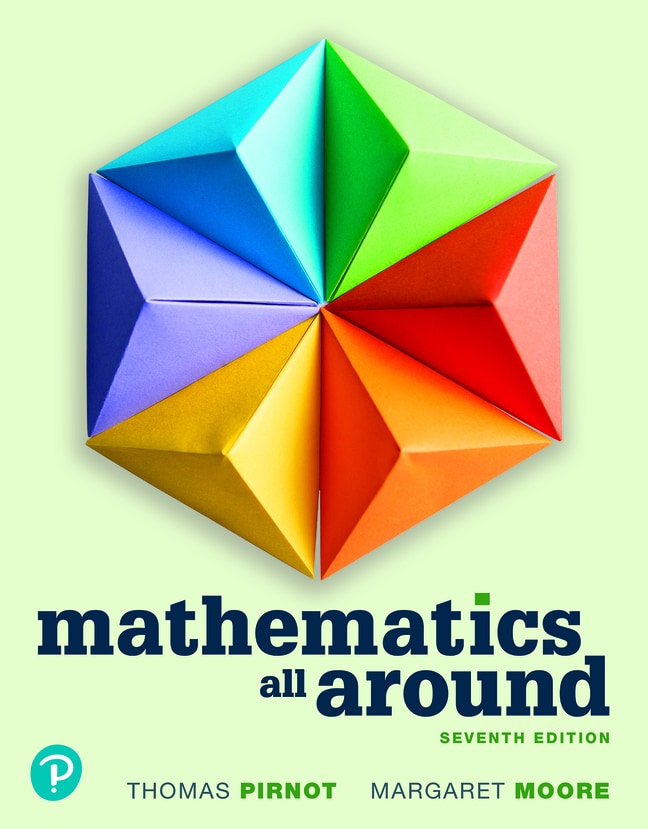
Mathematics All Around, 7th edition
- Thomas Pirnot
- , Margaret Moore

- Watch and learn
Videos & animations bring concepts to life
- Listen on the go
Learn how you like with full eTextbook audio
- Find it fast
Quickly navigate your eTextbook with search
- Stay organized
Access all your eTextbooks in one place
- Easily continue access
Keep learning with auto-renew
In a world where information and misinformation spread rapidly, it's important to learn now to think critically and become comfortable with numerical information. The applications, problem-solving emphasis, and clear writing of Mathematics All Around make it an interesting and relevant program for students of all levels and backgrounds. With new co-author Margaret Moore, the 7th Edition explores various apps, spreadsheets, and other technologies, incorporates GeoGebra and Excel Spreadsheets in some examples, and more. It is also ideal for students who need to satisfy a 1- or 2-course math requirement to transfer or graduate.
Published by Pearson (June 29th 2021) - Copyright © 2022
ISBN-13: 9780137383962
Subject: Liberal Arts Math
Category: Liberal Arts Math
1. Problem Solving: Strategies and Principles
- 1.1 Problem Solving
- 1.2 Inductive and Deductive Reasoning
- 1.3 Estimation
- Chapter Summary
- Chapter Review Exercises
- Chapter Test
2. Set Theory: Using Mathematics to Classify Objects
- 2.1 The Language of Sets
- 2.2 Comparing Sets
- 2.3 Set Operations
- 2.4 Survey Problems
- 2.5 Looking Deeper: Infinite Sets
- Chapter Summary
- Chapter Review Exercises
- Chapter Test
3. Logic: The Study of What's True or False or Somewhere in Between
- 3.1 Statements, Connectives, and Quantifiers
- 3.2 Truth Tables
- 3.3 The Conditional and Biconditional
- 3.4 Verifying Arguments
- 3.5 Using Euler Diagrams to Verify Syllogisms
- 3.6 Looking Deeper: Fuzzy Logic
- Chapter Summary
- Chapter Review Exercises
- Chapter Test
4. Graph Theory (Networks): The Mathematics of Relationships
- 4.1 Graphs, Puzzles, and Map Coloring
- 4.2 The Traveling Salesperson Problem
- 4.3 Directed Graphs
- 4.4 Looking Deeper: Scheduling Projects Using PERT
- Chapter Summary
- Chapter Review Exercises
- Chapter Test
5. Numeration Systems: Does It Matter How We Name Numbers?
- 5.1 The Evolution of Numeration Systems
- 5.2 Place Value Systems
- 5.3 Calculating in Other Bases
- 5.4 Looking Deeper: Modular Systems
- Chapter Summary
- Chapter Review Exercises
- Chapter Test
6. Number Theory and the Real Number System: Understanding the Numbers All Around Us
- 6.1 Number Theory
- 6.2 The Integers
- 6.3 The Rational Numbers
- 6.4 The Real Number System
- 6.5 Exponents and Scientific Notation
- 6.6 Looking Deeper: Sequences
- Chapter Summary
- Chapter Review Exercises
- Chapter Test
7. Algebraic Models: How Do We Approximate Reality?
- 7.1 Linear Equations
- 7.2 Modeling with Linear Equations
- 7.3 Modeling with Quadratic Equations
- 7.4 Exponential Equations and Growth
- 7.5 Proportions and Variation
- 7.6 Modeling with Systems of Linear Equations and Inequalities
- 7.7 Looking Deeper: Dynamical Systems
- Chapter Summary
- Chapter Review Exercises
- Chapter Test
8. Consumer Mathematics: The Mathematics of Everyday Life
- 8.1 Percents, Taxes, and Inflation
- 8.2 Interest
- 8.3 Consumer Loans
- 8.4 Annuities
- 8.5 Amortized Loans
- 8.6 Looking Deeper: Annual Percentage Rate
- Chapter Summary
- Chapter Review Exercises
- Chapter Test
9. Geometry: Ancient and Modern Mathematics Embrace
- 9.1 Lines, Angles, and Circles
- 9.2 Polygons
- 9.3 Perimeter and Area
- 9.4 Volume and Surface Area
- 9.5 The Metric System and Dimensional Analysis
- 9.6 Geometric Symmetry and Tessellations
- 9.7 Looking Deeper: Fractals
- Chapter Summary
- Chapter Review Exercises
- Chapter Test
10. Apportionment: How Do We Measure Fairness?
- 10.1 Understanding Apportionment
- 10.2 The Huntington—Hill Apportionment Principle
- 10.3 Other Paradoxes and Apportionment Methods
- 10.4 Looking Deeper: Fair Division
- Chapter Summary
- Chapter Review Exercises
- Chapter Test
11. Voting: Using Mathematics to Make Choices
- 11.1 Voting Methods
- 11.2 Defects in Voting Methods
- 11.3 Weighted Voting Systems
- 11.4 Looking Deeper: The Shapley-Shubik Index
- Chapter Summary
- Chapter Review Exercises
- Chapter Test
12. Counting: Just How Many Are There?
- 12.1 Introduction to Counting Methods
- 12.2 The Fundamental Counting Principle
- 12.3 Permutations and Combinations
- 12.4 Looking Deeper: Counting and Gambling
- Chapter Summary
- Chapter Review Exercises
- Chapter Test
13. Probability: What Are the Chances?
- 13.1 The Basics of Probability Theory
- 13.2 Complements and Unions of Events
- 13.3 Conditional Probability and Intersections of Events
- 13.4 Expected Value
- 13.5 Looking Deeper: Binomial Experiments
- Chapter Summary
- Chapter Review Exercises
- Chapter Test
14. Descriptive Statistics: Making Sense of the Data
- 14.1 Organizing and Visualizing Data
- 14.2 Measures of Central Tendency
- 14.3 Measures of Dispersion
- 14.4 The Normal Distribution
- 14.5 Looking Deeper: Linear Correlation
- Chapter Summary
- Chapter Review Exercises
- Chapter Test